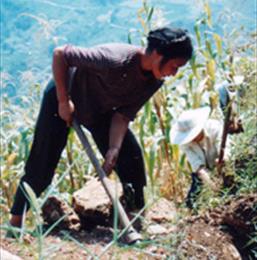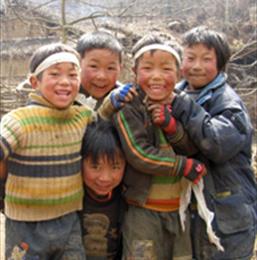Oct/Nov 2003
30th November 2003
Social and Community Forest Projects
DORS first started implementing social and community forestry projects in 1998. The aim of the initial projects was to establish tree species that produce economically viable non-timber forest products (NTFP), such as fruit, in individual farmer's agricultural land. The revenue made from the sale of the NTFP's in the local markets then helps the villagers in their fight against poverty and enables future investment in further forestry projects and other enterprises.
Social and community forestry projects are implemented in conjunction with other poverty alleviating measures in DORS target villages. Forestry projects now range from the establishment of a few saplings in individual farmers' agricultural land (as with the first projects in 1998) to larger forestry projects. The community and their ideas for development determine the choice of project, be it for poverty alleviation or for the environmental benefits - such as protection against soil erosion - or both.
In some locations, lack of technical skills hinders the ability of local communities to manage their forestry plots well, and there is a need to adapt their management methods. DORS assists by providing appropriate training to empower the local communities to enhance their capabilities in forestry management.
Forestry Evaluation
DORS has carried forestry projects in 13 administrative villages, a total of 1165 households for a population of 4412 took part in these projects. So far a total of RMB 474,881.30 (GBP 36,530) has been expended on DORS forestry projects. These villages were interested in forestry for both improving household income and for environmental benefits. Although forestry is a long-term investment, there is still high interest in remote villagers of Hanyuan where agricultural conditions are often poor.
At the end of each project DORS conducts a basic evaluation. However, with Forestry it is not easy to see results in the short-term.
To better understand the chances of future success, DORS carried out a detailed forestry evaluation over the last few months. DORS forestry officer, Guo Yumei visited all the 13 villages once more to conduct a study including survival rates, training impact, and nursery production.
The main points the report highlights are the importance of careful design of post planting management systems, awareness of transport problems, verifying specific varieties at nurseries, seasonality, and various aspects of improving training, the careful assessment of villagers' level of interest and the damage caused by animals' grazing to the forests.
Overall, the survival rates have been satisfactory. In some cases, the survival rates for environmental trees have been found to be lower than the ones grown for an economic output. This was due to villagers having less interest in those trees, therefore they had not managed them as well as those having an income generating value such as walnut and chestnut, which were found to have a much higher survival rate.
Generally, the small-scale nursery experiments were not successful due to insufficient training of villagers and insufficient follow-up.
DORS forestry evaluation report is available in Chinese.
This evaluation study is part of a new MRDF funded project (total budget RMB 372,420-GBP 28,000) that will provide additional forestry training to all these villages, two new forestry projects, and provide on the job training for two to four community development workers over a 2-year period.
Completion of the Misereor funded Integrated Rural Development Programme
The programme ended this October, with the completion of the integrated project carried out in Dawan Village, Henan Township. The programme also included the construction of a water supply project in Songjiang Village, in Xixi Township and another one in Wenzeluo Village, Ganluo County, and a Community Forestry Project in Xiangshu Village, Fuquan Township.
Dawan Village has seen many changes since DORS started working there. One school, with playground and toilet facilities has been rebuilt, and another school has been repaired with the building of a new kitchen, surrounding wall and playground. One hamlet is now connected to electricity with hydro-power as mentioned in DORS last newsletter, grain grinders are now owned by every 2-3 households for joint use which will improve efficiency of livestock production, new breeds of goat have been delivered for improving the village goat stock and increasing marketability. School children have now been supported for three semesters to attend the village schools, therefore attendance rates have increased. A bridge is being built after it was destroyed in last year's floods. Livestock shelters have been built in 9 households. The total cost of the project in Dawan was RMB 70,000 (GBP 5,385). Zhang Guoping of Hanyuan County Poverty Alleviation Office assisted DORS with managing this project.
DORS News and Information
The Liangshan Prefectural People's Association for friendship with foreign countries held the Conference for experience sharing and exchange with friendly international experts, Hongkongnese, Macaonese and Taiwanese in Xichang from 20-22 November. The conference was co-hosted by the Liangshan Project Office of Japan International Co-operation Agency (JICA) and brought together participants from foreign and domestic NGO's around the country. It provided a communication opportunity and acted as a communication platform for NGOs working in the prefecture.
Four organisations were given the chance to introduce their work, including DORS. We presented our uses of participatory approaches in project development at the village level. DORS Forestry Project Officer Guo Yumei and Project Assistant Li Cai Hong were able to take part in this conference.
Presentation in UK
DORS trustee Derek Acock was asked to give two talks recently about DORS activities in Sichuan. The first was to North Gloucester Rotary Club Ladies Group in September. The second was to The Probus Club in Upton St Leonards, Gloucester in October. Donations of GBP 60 were collected.


